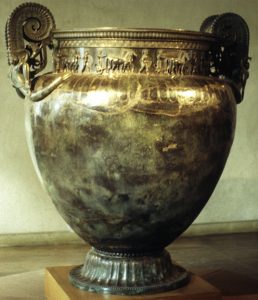Cahokia is an ancient culture and city near Modern St. Louis that reveals much about the North American Indigenous history. It greatly affected the surrounding cultures of Indigenous societies, and the world is still feeling these effects today. However, the presence of Cahokia is not well-known to the general American public today, and the lack of Cahokia monuments does not help Cahokia become known to a variety of people. Thus existing monuments, like Woodhenge, are significant to the history of the site. Woodhenge is a monument very similar to Stonehenge, with its circle of wooden posts that aligns itself with astronomical and geometric qualifications (Pauketat 2009, 62). Its availability to the public is only possible because of the reconstruction done by archaeologists, opening up a path to Cahokia knowledge.
The discovery of Woodhenge was accidental in the late 1960s, “Dr. Warren Wittry was studying excavation maps when he observed that numerous large oval-shaped pits seemed to be arranged in arcs of circles” (Keller, Young, Kronk 2022). Because of the careful arrangement of the holes, excavations continued, and posts made of red cedar were found alongside the post holes. This red cedar is significant to some Indigenous cultures in North America, and this representation suggests Woodhenge was possibly also sacred to the people of Cahokia. Because of this, in the reconstruction of Woodhenge, the team made sure to use red cedar logs, and when they couldn’t, they used black locusts instead that were painted red (Iseminger 2009). Thus, using the red cedar logs wasn’t just for accuracy; they also could convey to the visitors of Cahokia that red cedar is sacred to these cultures and keep the history of this connection alive.

Figure 1. The red cedar logs in the recreation of Woodhenge. Photograph by John W. Schulze. April 2, 2010. Woodhenge and Monk’s Mound, Cahokia Mounds. Flickr.
Besides the reconstruction making an attraction that appeals to those who might want to visit, it also suggests the organization of the Cahokian people. The well-thought-out post holes are, “incontrovertible evidence of an ancient American Indian civilization with a sophisticated understanding of geometry, astronomy, and calendrics” (Pauketat 2009, 62). This structure reflects the large-scale planning that must have gone on to create such an incredible creation. The people had to carefully plan how the posts would align with astronomical and calendar events, and they had to use geometry to do so. Thus, reconstruction isn’t just valuable to show what Cahokia would’ve been like back in 1050. Reconstruction of the monument also helps reconstruct mindsets. By showing the general public that past Indigenous people were capable of such structures that display a thought-out plan, we can begin to deconstruct the idea that Native people were not intelligent and only gained knowledge when Europeans came to America.

Figure 2. Layout of Woodhenge displaying the relationship between the poles and astronomy. Photograph by Herb Roe. Creative Commons Attribution-Share Alike 4.0 International license.Wikimedia Commons
Cahokia is just the beginning of teaching the world of ancient Indigenous cultures. By exposing structures like Woodhenge to people, an interest in learning more might be sparked, allowing history to include more truths about the Americas before European colonization. Reconstruction is the first step to reaching a more accurate understanding of the past and should be valued more when examining history.
Further Readings:
https://www.onlyinyourstate.com/illinois/woodhenge-il/
https://scienceviews.com/indian/woodhenge.html
References
Keller, Ken and Young, Eric and Kronk, Gary. 2022. “Woodhenge”. Cahokia Mounds State Historic Site and Cahokia Mounds Museum Society. https://cahokiamounds.org/explore/#tab-id-4
Iseminger, William R. August 28, 2009. “The Skywatchers of Cahokia”. Mexicolore https://www.mexicolore.co.uk/aztecs/home/skywatchers-of-cahokia
Pauketat, Timothy R. 2009. Cahokia: Ancient America’s Great City on the Mississippi


